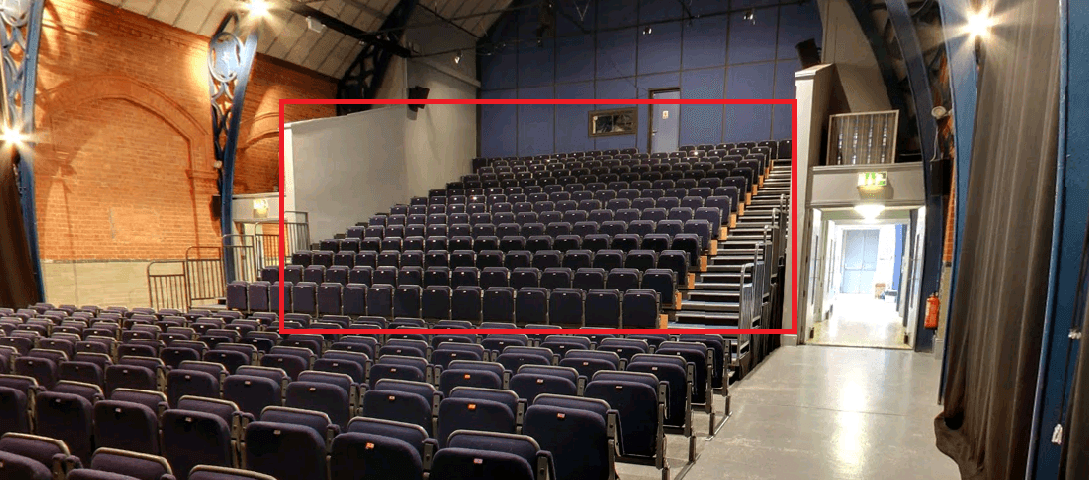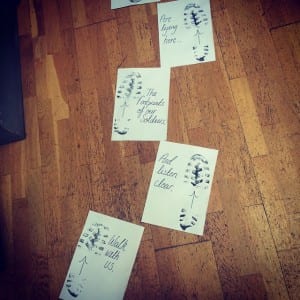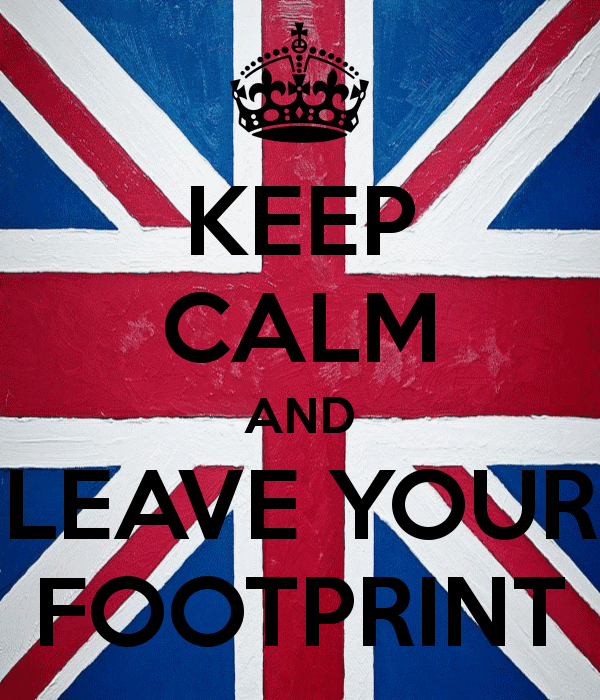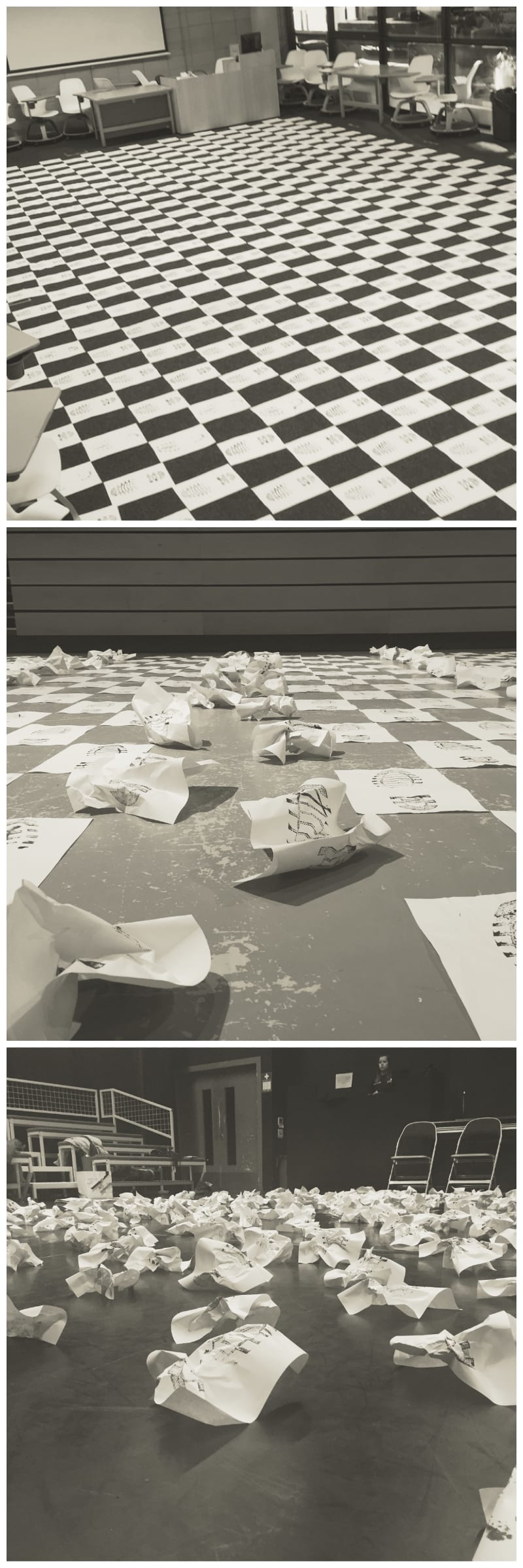“We Need You and Your Footprints” was a site-specific performed installation which took place at the Drill Hall, located on Free School Lane in Lincoln city centre. This performance took place on Friday 8th May 2015, and it was scheduled to be performed twice throughout the day. The audience were welcome to come and go as they pleased. The performance lasted for 16 minutes and 40 seconds and within this time we transformed the installation into three different stages.
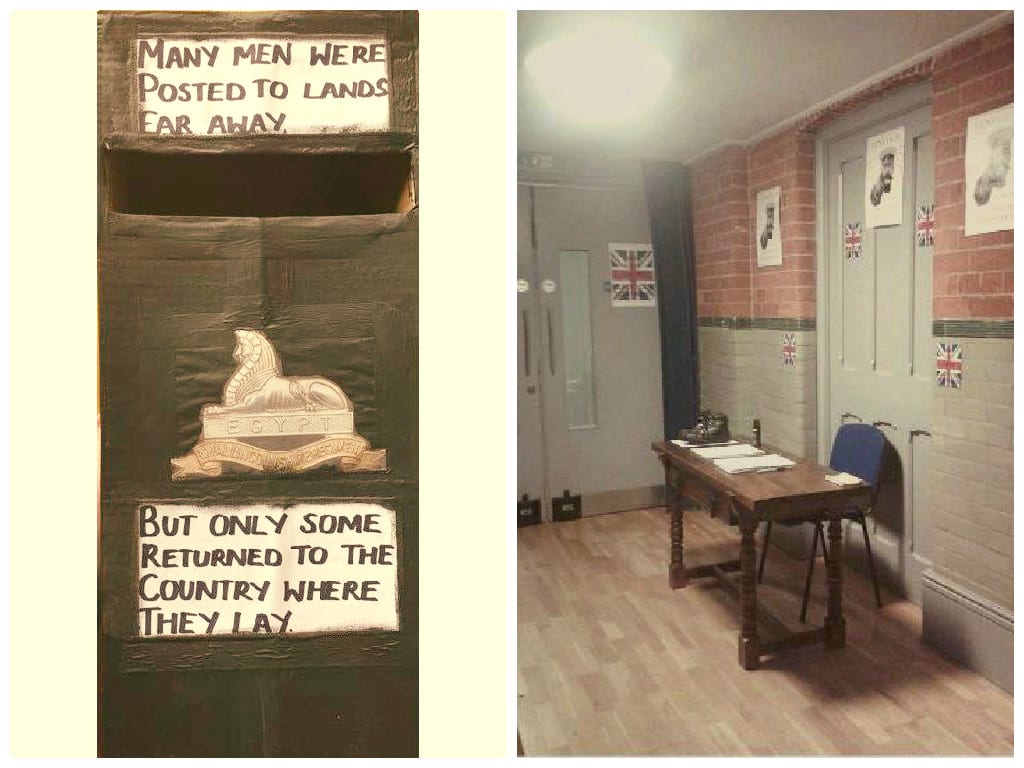
Pacey, C, (2015). ‘Recruitment Station and Post Box’.
We chose to install our piece in the auditorium of the Drill Hall. A majority of the area was being used by the technicians between our performances, and we only used a small section of the auditorium located between two walls that usually housed the raked seating when assembled for performances. Between the two walls we had laid out 500 footprints, at the back parallel to the seating we had a free standing projector screen to display our video. The auditorium was also a walkway through to other performances, hence why our piece worked well in the space as we didn’t expect the audience to stay for the duration of our performance. Before the audience entered the auditorium, they were welcomed by Laura Baillie who was sat at our ‘recruitment station’ where members of the public were encouraged to become involved in our pre-performance. This consisted of them printing a boot print and signing it, they were then instructed to enter the auditorium and replace a footprint that had previously been arranged in the performance area, with the footprint they had signed. They were then asked to post the old footprint into a black post box, located to the left of the double doors.
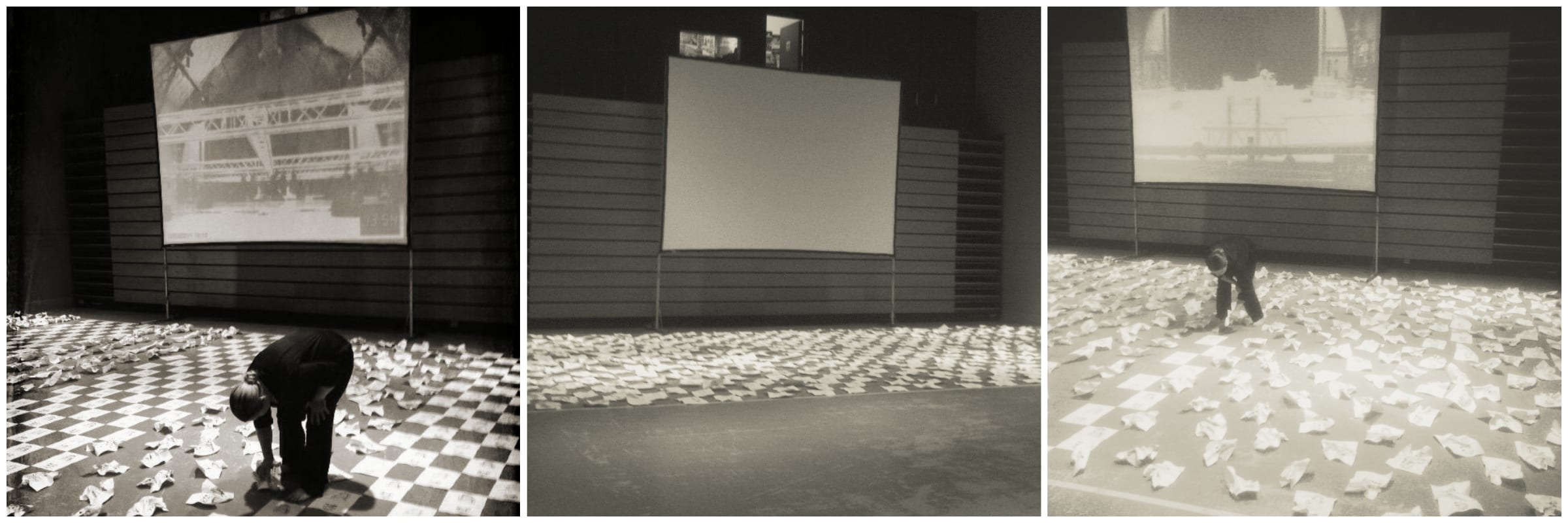
Pacey, C, Baillie, L, Boughen, L, (2015). ‘We Need You and Your Footprints Performance’.
Our piece focused on the soldiers that used to train at the Drill Hall, specifically the Lincolnshire Regiment 4th Battalion. Over our two performances we laid a total of 1000 footprints to represent 1000 soldiers that were in a battalion. A diagram from the Lincolnshire County Council website which stated “Battalion: 1000 men commanded by Lt Colonel” (Lincolnshire.gov.uk, 2015) gave us the idea to shorten our piece to 1000 seconds, or 16 minutes and 40 seconds instead of a durational piece of 3 hours, that had no meaning behind it.
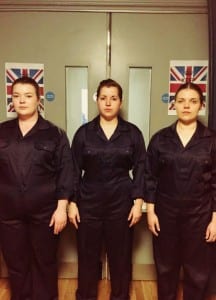
Boughen, L, (2015) ‘Costume’
We were dressed in navy overalls and our hair was styled in low buns. We chose to use this type of costume because we weren’t representing anyone specifically throughout our piece, as we were juxtaposing the (contemporary use of the) Drill Hall, as opposed to what the Drill Hall was originally used for, so throughout our performance we were representing both Technicians and Soldiers. Instead of wearing shoes, we chose to do our piece in bare feet so that we were physically connecting with the Drill Hall. We were each leaving our individual footprint on the floor of the auditorium, although invisible to the naked eye it could be seen with the right lighting (UV).
We used a time lapse video from the Drill Halls website which played on a loop for the duration of our performance. In the corner of the video we had a timer that counted down from 16 minutes and 40 seconds, this was because our piece as a whole was centred on the number 1000. We also wanted to give ourselves a short time limit because the soldiers would have been expected to be fully trained and sent to war in a short amount of time. “Many men arrived at the fighting fronts utterly unprepared for the experience.” (Baker, 2015)
Our performance was split into three sections. The first being the instalment you see when entering the auditorium, 500 pristine footprints laid in left, right formation. Secondly, in unison we went along 8 rows each of 21 footprints and screwed them up. Finally, we went along each row again straightening out the footprints, so that the image was similar to the one first seen. Each stage represented a soldier’s time during war, the first being the men joining the volunteer army as husbands, fathers and sons. The second stage symbolised the men being injured mentally and physically and the final stage symbolised the men weren’t the same due to the mental and physical trauma they were subjected to. We wanted to show the fundamental elements of war, before, during and the aftermath.
First Thoughts about the Site
Upon visiting the Drill Hall for the first time as a performer and not as a customer, I struggled to instantly get ideas of how I could utilise the space. However, site-specific performance was still very foreign to me at this time, and I had no concept of what was expected of me until very late into the performance process. However, the building’s history was extremely interesting and there were so many elements that as a class we could represent, many of which the general public would be oblivious to.
“Site, as concept, must be connected with place and locale, as the natural and cultural are entwined in a true ecology which moves beyond these familiar dualism.” (Pearson and Shanks, 2001)
Starting Idea & Development of Idea

Pacey, C, (2015). ‘Idea Mind Map’.
“Performance may directly reference such aspects, or it may unwittingly rouse them. Any encounter with site is potentially divisive, recovering that which was lost – reawakening memories, stirring emotions, mobilizing causes.” (Pearson, 2010, 144) I thought for our performance we could reflect back by remembering the soldiers that were once within the building and to make the public are aware of what the Drill Hall used to be used for because, over time it is clear to see that it is no longer celebrated. I thought that the Drill Hall could utilise its previous uses a lot more, other than the plaques that hang on the walls. The building in itself holds enough history to create a museum. It was then how we could perform within the space we later found difficult.
During the early stages of our time at the site, we had several ideas which we explored individually and it wasn’t until mid-February that we settled as a group of three with a definite theme to base our piece around. It took a lot of research to formulate our idea, as a group we wanted to explore something that other groups weren’t already representing because we wanted to appreciate everything the Drill Hall had offered over its 125 years of existence. The obvious elements that nobody had chosen to explore further were the Drills that took place when the volunteer army trained there.

(Beck, n.d.)
We wanted to show this via the placement of the footprints, and so we placed them in a left, right formation to symbolise the men marching. Our initial thoughts involved the audience receiving information on a solider, to symbolise the men that were killed in battle with red footprints which would trigger a gun shot being fired over the sound system. We also explored the idea of creating a lasting image with the footprints after the 3 stages, the images we thought about for this were a map of Lincolnshire to symbolise the county regiment the men were apart of or the fleur-de-lys which is seen on the Lincolnshire county flag.
When researching art that had been made with footprints, I came across Simon Beck who creates mathematical geometric designs in the snow only using his footprints.
‘[…] He got the idea to draw a star on the small frozen lake in front of his place. […] The day after, looking down from the ski lift; he was impressed by the result. After the next snowfall, he repeated the exercise by creating an even more complex drawing. Snow Art was born.’ (Beck, 2015)
I liked the idea of the audience seeing a large scale piece of art that could represent so much. Although Beck’s art doesn’t have any specific meaning behind it, and he only does it for his own enjoyment, I liked the idea that he spends up to 12 hours physically exhausting him just so the skiers can appreciate art from the ski lifts. If the audience took nothing from our performance, and were oblivious to what site-specific performance was I hope that they too would have enjoyed seeing a large scale piece of transformation art. Our performance was on a much smaller scale compared to Beck’s however, as a group we were pushed to our physical limits, which we were doing on behalf of the soldiers. Also, every time Beck creates a piece of art, it is soon snowed over and he creates something completely new. His designs are never the same. This links nicely to our piece as our two performances were different to each other, because after the first performance we were physically drained but we had to continue to do another performance which caused the timings to be different because of our speed increasing due to fatigue.
During our classes we were asked to present to the class about certain site specific performers or performances that we took influence from. One company that stood out to us the most were Lone Twin, and upon researching them we liked the idea of involving the community within our piece.
‘Public engagement, public projects with volunteers from the community that happen in a public space’ (Lone Twin, 2011).
We wanted the audience to volunteer similar to how the soldiers would’ve done, and so the audience were invited to print a footprint and sign it with their name, and for them then to replace a footprint that had already been laid in the performance space. We used this to juxtapose the past and the present. We had unsigned footprints representing the soldiers and a different patterned boot print to represent the people that were entering the site today, and tomorrow they would also be a part of its history.

(Naderi, 2011)
The idea to incorporate the audience also originated when researching Rajni Shah’s ‘Glorious’ although the piece wasn’t site specific, it encouraged the audience to participate within the performance by placing flowers on the stage and exiting through the playing space. We applied this in our performance when getting the public to place their footprints within our pre-placed grid of footprints, we encouraged them to follow the pattern that was already made, but to explore throughout the spaces left and to place their footprint wherever they desired.
Over our research period we experimented placing the footprints to several different sounds and rhythms such as war poems and war time music. After rehearsing with these tracks several times we felt that the changes in tempo weren’t representing the mundane task of training for the army. This is because the men wouldn’t have been allowed to fall out of line and if they had, they would have immediately been reprimanded for it. Shortly after, we decided to experiment with the ticking of a clock, as this was a repetitive sound and would emphasize the consistency of the volunteers training routines. It would also give us a good rhythm to keep in time when choreographing the piece. We later decided to change a ticking clock, into a constant repetition of left, right, left, right.
Instead of incorporating poems that were already published and were very general about war, we decided to create short four line poems to explain our piece and the space or to direct the audience.
- “Walk with us, and listen clear, the footprints of our soldiers, are lying here” (Baillie et al, 2015) welcomed the audience into our piece and directed them to the recruitment station, which also informed the audience that the soldiers were once in the space that our performance was taking place in.
- “You may wish to leave, but feel free to stay; our piece will progress, so return through the day.” (Baillie et al, 2015) This encouraged the audience to return but not to feel that they had to be present for the entirety of the performance as we understood that our piece was repetitive, and it wasn’t to entertain an audience but rather, it was symbolizing and bringing to life the ordeals of a solider in the war.
- Printed on the black post box was “Many men were posted to lands far away, but only some returned to the country where they lay.” (Baillie et al, 2015) We symbolized the large stone plaque that is located in the café bar with this particular poem, many of the men from the 4th Battalion were posted to Egypt, which is why we decided to have a post box as the audience were sending the soldier who was being represented by the footprint they picked and they were posting him to Egypt.
We were scheduled to visit the Archives during one of site based classes, whilst doing so
we saw several wartime recruitment posters which we then thought we could apply to our performance when advertising and when setting up our recruitment station. We wanted to symbolize the recruitment propaganda but to relate it to our piece. Each poster was given a typical World War One look and was based on posters
we’d researched, but the information on it was for our performance and they were informed as to where the performance would be and when.
As previously stated, we wanted to juxtapose the use of the building now as well as the use of the building when the soldiers were using for training. During our theory classes, Michael displayed a video that the Drill Hall had uploaded to their website of the technical team fitting the rig but it was shortened into a 3 minute video through time-lapse editing. After seeing this video we wanted to incorporate it into a Post-Performance, which would involve our video alongside the one the Drill Hall provided to show two contrasting installments that are representing the building in two contrasting ways.
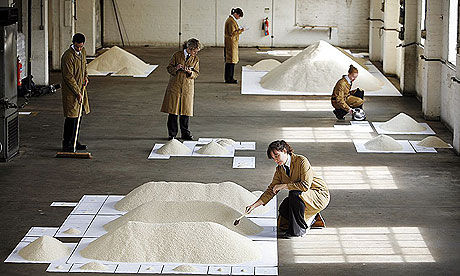
(Sillitoe, D, 2008)
During our research relating to numbers and how we would install 1000 footprints over our time at the Drill Hall we looked into Stan’s Café ‘Of All The People In All The World’ which showed statistics in the forms of piles of rice.
“The statistics are arranged in labelled piles creating an ever changing landscape of rice. The statistics and their juxtapositions can be moving, shocking, celebratory, witty and thought provoking.” (Stanscafe.co.uk, 2015) As a group we wanted the audience to visualize the vast number of people who used to inhabit the building, who went on to fight for our country and potentially their lives, and all of which at the same time were part of the Lincolnshire community.
During our time at the Drill Hall we were informed that the votes would be counted there the day prior to our performances, to connect this to our performance we painted our post box black, to resemble a ballot box. Although this was only a loose connection we wanted to symbolise several elements when performing at the Drill Hall, to emphasise its vast number of uses.
Performance Evaluation
Our performance allowed the audience to stay as little or as long as they wished and whilst performing we were unaware of how many people were watching us at any time, as we were permanently looking down throughout the performance. We had a good response when inviting people to get involved with our pre-performance recruitment section.
After speaking to our marker about our performance, we thought that it would have been effective if we’d used the footprints after our performance
to symbolize something else, such as burying a number of them to represent the men from the 4th Battalion that died in service.
Screwing up the paper in the first section of our performance worked particularly well as we all kept in time with the left, right soundtrack that played throughout. This was effective as we were symbolizing the soldiers in marching formation as they would have all been regimented. However, when it came to the straightening out section of our piece it became physically demanding. Our legs began to hurt and the physicality of our piece started to make us hot and irritable. I personally began to speed up during this time as I became fatigued and in pain. This didn’t affect our performance because each image was still visually stimulating. This just emphasized that each human’s abilities are different, many men in the war would have found the physical excursion would take a toll on their bodies and some men would have excelled to prestigious positions within the army whilst leaving the friends they were once in training with behind. It wasn’t expected, however I appreciated the meaning behind it, and mankind can’t be in unison with each other all the time. Someone is always in charge or ahead of the rest.
The only thing I would have changed about our final performance is the time we had to rehearse in our performance space. As a group when we had finalized all our ideas and were able to rehearse our piece fully, the space wasn’t available to us. Other than this I wouldn’t have changed my time at the Drill Hall as I enjoyed it thoroughly. However, because the Drill Hall is a functioning public place that is open to several shows a month, and are open six days a week to the public it was almost impossible for us to rehearse in our space. On performance day we hadn’t ever successfully ran our piece, the only spaces available to us within the university were only large enough to practice with half the footprints we needed for our performance.
After taking the site-specific module I understand that there are several different pieces of art that could come under performance, until now I thought that Drama meant working with scripted work, devised pieces or improvisation. I was oblivious to the fact that performance can be anything and I now appreciate site specific performance a lot more. I also understand that it can be used to convey powerful messages in a creative way. Not everyone may understand it, but it’s all about how the audience perceives it because art can be seen differently by everyone.
Baillie, L, Boughen, L, Pacey, C. (2015) We Need You and Your Footprints. [performance] Lincoln: Lincoln Drill Hall, 8th May.
Baker, C. (2015). Training to be a soldier in the British Army in 1914-1918. [online] 1914-1918.net. Available from: http://www.1914-1918.net/training.htm [Accessed 14 May 2015].
Beck, S. (2015). Simon Beck’s Snow Art Gallery. [online] Snowart.gallery. Available from: http://snowart.gallery/about_Simon_Beck.php [Accessed 13 May 2015].
Beck, S. (n.d.). Snow Art. [image] Available from: http://snowart.gallery/see.php?s=Snow%20Art&p=4 [Accessed 15 May 2015].
Davies, D. (2015) Left, Right Clip. [sound]
Grimshaw, O. (2015) Time Lapse Performance Video.[Video]
Lincolnshire Regiment Cap Badge. (n.d.). [image] Available at: http://www.northeastmedals.co.uk/british_regiment/lincolnshire_regiment.htm [Accessed 15 May 2015].
Lincolnshire.gov.uk, (2015). Royal Lincolnshire Regiment During World War I | Lincolnshire County Council. [online] Available from: http://www.lincolnshire.gov.uk/residents/archives/collections/guides-to-sources/royal-lincolnshire-regiment-during-world-war-i/118960.article [Accessed 12 May 2015].
Lone Twin (2011) MINTO:LIVE 2011 Lone Twin’s Street Dance. [online video] Available from: https://vimeo.com/18849232 [Accessed 9 March 2015].
Naderi, P. (2011). Glorious – SPILL Festival. [image] Available from: http://www.rajnishah.com/files/images/glorious-spill.jpg [Accessed 13 May 2015].
Pearson, M. (2010). Site-specific performance. Houndmills, Basingstoke, Hampshire: Palgrave Macmillan.
Pearson, M. and Shanks, M. (2001). Theatre/archaeology. London: Routledge.
Shah, R, (2011). Glorious. [image] Available from: http://www.rajnishah.com/files/images/glorious-spill.jpg [Accessed 12 May]
Sillitoe, D. (2008). “Of all the People in all the World” – Stan’s Cafe. [image] Available from: http://www.theguardian.com/stage/2008/sep/17/theatre [Accessed 12 May 2015].
Stanscafe.co.uk, (2015). Stan’s Cafe Theatre Company: Of All The People In All The World. [online] Available from: http://www.stanscafe.co.uk/project-of-all-the-people.html [Accessed 13 May 2015].
Stan’s Cafe, (2008). Of All The People In All The World. [image] Available from: http://www.stanscafe.co.uk/project-of-all-the-people-birmingham2.html#images [Accessed 13 May 2015].
Through the Lens Photography, (2012). Lincoln Drill Hall Auditorium. [image] Available from: https://www.google.co.uk/maps/place/Lincoln+Drill+Hall/@53.229899,-0.537489,3a,75y,106.72h,90t/data=!3m4!1e1!3m2!1sXYEqTIEHalG5Af8ZkqBqlA!2e0!4m2!3m1!1s0x0:0xa4c31b2c989204fd!6m1!1e1?hl=en [Accessed 15 May 2015].


